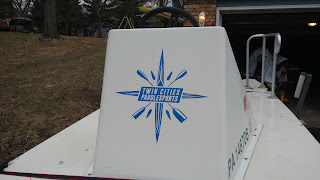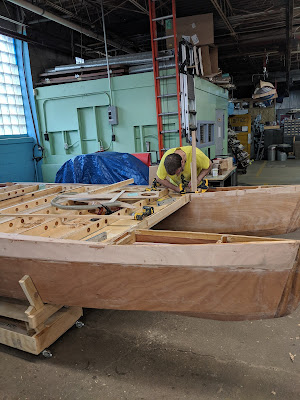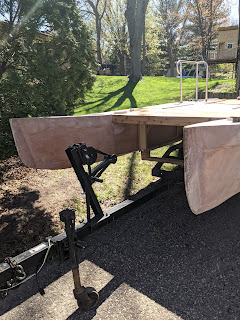Welcome
Note: This build began with assistance from Richard Woods (https://sailingcatamarans.com), who allowed us to acquire the plans and adapt his Skoota design to fit our build requirements. We are feeding back our build to Richard for possible inclusion in a more formal offering of the Skoota "16". Any inquiries about plans, costs, etc. should be directed to him, with our gratitude.
Another note - most of this build is being done in metric. However, since most of my audience is used to inches, feet and pounds, we'll express dimensions in those terms. My apologies to those used to the better system. Magic numbers 25.4, .0394, .454, 2.2, 1.61, .62. Oh, and 42.
When we formed the club in early 2017, I knew we would need a launch, and found a very good deal in Philadelphia. A flying trip back east, and we had a boat. And, it was the right boat for us for the time. However... Years of sitting on the water/dock on boathouse row left the little boat with a few small leaks in the hull, and a lot of perforations in the deck. And perforations left un-treated equal a balsa byproduct that resembles black pudding. Residual strength - zero. Two thin pieces of fiberglass holding up a pocket full of water and goo.
Over this winter, we had plans to rebuild the deck and raise the hulls (the early Wintechs were not intended to carry a 220lb coach and a 100lb battery). But after assessing the project, we decided that there might be a 'better way'.
 The reason for building a boat like this is to chase kayaks - not recreational boats, but Olympic Sprint canoes and kayaks. 17' long, 16" wide, 25lb, round bottomed and zero primary or secondary stability. They're designed for just one thing: to cover 200-1000meters as fast as possible! With the lack of stability, and since the boats are really optimized for flat water, you need a boat that puts up as small a wake as possible. I'm not a Naval Architect, and struggle with things like Froude and Kelvin numbers, and so on, but I've observed enough boats to understand that a high prismatic coefficient, long waterline and low displacement seem to do better at generating low wake.
The reason for building a boat like this is to chase kayaks - not recreational boats, but Olympic Sprint canoes and kayaks. 17' long, 16" wide, 25lb, round bottomed and zero primary or secondary stability. They're designed for just one thing: to cover 200-1000meters as fast as possible! With the lack of stability, and since the boats are really optimized for flat water, you need a boat that puts up as small a wake as possible. I'm not a Naval Architect, and struggle with things like Froude and Kelvin numbers, and so on, but I've observed enough boats to understand that a high prismatic coefficient, long waterline and low displacement seem to do better at generating low wake.
We started out with a 'boat in a box' concept - 16'LOA, 7' beam, around 12" freeboard, a net displacement of about 500lb, and a wet displacement of around 900-1000lb. Speed with a Torqeedo electric in the 12mph range. Once we defined the box, we started to research and actually learn the science behind catamarans - which is very different than for a monohull!
My original build crew started to discuss options, and Dan found plans for an 18' power cat designed by Richard Woods. The Skoota 18 is a great pocket cruiser, very efficient design, but too long/wide for our purposes, and intended to fold up onto a trailer. We needed something a little simpler. After contacting Richard and describing the project, he suggested we scale down his 30' boat, and build a deck to suit our criteria. This is a design well suited to the homebuilder with limited space and a limited budget. I won't attempt to describe what 'should have been' for the cockpit module. We have a deck that's 7' wide by 10'long, and flat as a board, with 'deck furniture sprouting up. Very utilitarian, and fairly straightforward.
The scaled down Skoota 30 came out to be just under 16' long, and with a little persuasion, came it at 7' wide. Why 7 feet? Due to wake interference and drag from the hull wakes colliding right under the back of the boat, a wider cat is faster. An 10' wide design would pretty much eliminate this problem, but it would aslo eliminate being able to park the boat in a shipping container. So we have a real limitation of 7'3".
Another note - most of this build is being done in metric. However, since most of my audience is used to inches, feet and pounds, we'll express dimensions in those terms. My apologies to those used to the better system. Magic numbers 25.4, .0394, .454, 2.2, 1.61, .62. Oh, and 42.
The project
You may have linked here from TCPaddlesports.com or our Facebook page. Or maybe from some other post. In any case, this will be the story (hopefully not too long) of building a new low wash launch for our canoe/kayak racing club. |
| RIP "Murphy" our aging coach launch |
Over this winter, we had plans to rebuild the deck and raise the hulls (the early Wintechs were not intended to carry a 220lb coach and a 100lb battery). But after assessing the project, we decided that there might be a 'better way'.
The design
 The reason for building a boat like this is to chase kayaks - not recreational boats, but Olympic Sprint canoes and kayaks. 17' long, 16" wide, 25lb, round bottomed and zero primary or secondary stability. They're designed for just one thing: to cover 200-1000meters as fast as possible! With the lack of stability, and since the boats are really optimized for flat water, you need a boat that puts up as small a wake as possible. I'm not a Naval Architect, and struggle with things like Froude and Kelvin numbers, and so on, but I've observed enough boats to understand that a high prismatic coefficient, long waterline and low displacement seem to do better at generating low wake.
The reason for building a boat like this is to chase kayaks - not recreational boats, but Olympic Sprint canoes and kayaks. 17' long, 16" wide, 25lb, round bottomed and zero primary or secondary stability. They're designed for just one thing: to cover 200-1000meters as fast as possible! With the lack of stability, and since the boats are really optimized for flat water, you need a boat that puts up as small a wake as possible. I'm not a Naval Architect, and struggle with things like Froude and Kelvin numbers, and so on, but I've observed enough boats to understand that a high prismatic coefficient, long waterline and low displacement seem to do better at generating low wake.We started out with a 'boat in a box' concept - 16'LOA, 7' beam, around 12" freeboard, a net displacement of about 500lb, and a wet displacement of around 900-1000lb. Speed with a Torqeedo electric in the 12mph range. Once we defined the box, we started to research and actually learn the science behind catamarans - which is very different than for a monohull!
The scaled down Skoota 30 came out to be just under 16' long, and with a little persuasion, came it at 7' wide. Why 7 feet? Due to wake interference and drag from the hull wakes colliding right under the back of the boat, a wider cat is faster. An 10' wide design would pretty much eliminate this problem, but it would aslo eliminate being able to park the boat in a shipping container. So we have a real limitation of 7'3".
The space
Do you know how hard it is to find affordable space for working with wood
and fiberglass? If you aren't blessed with a heated pole barn, you're in trouble. We scouted around, and found a site called the "Hack Factory". Tools, heat, ventilation, a real tablesaw, and a dingy little room off to the side of the welding shop that measures 10'x20'. Just barely big enough to assemble a hull and store some materials.
and fiberglass? If you aren't blessed with a heated pole barn, you're in trouble. We scouted around, and found a site called the "Hack Factory". Tools, heat, ventilation, a real tablesaw, and a dingy little room off to the side of the welding shop that measures 10'x20'. Just barely big enough to assemble a hull and store some materials.
There's a nominal monthly fee ($55), and we bought 3 memberships for the guys working the most on the project.
Next steps
Over the coming days, I'll try to catch up on where we've been, and what's coming up. Once I catch up, I'll do a bit more 'normal' build blogging.
Hope you enjoy!




Comments
Post a Comment